
The Mighty Music Hall Organ: A Cautionary Tale
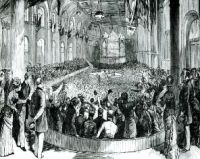
Scott Santangelo, director
of operations at Music Hall, has a display on the wall of his office,
five wooden, stopped-flute pipes from the original Music Hall pipe organ.
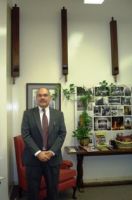
Custom-built by Hook and
Hastings of Boston, the organ made its debut, along with Music Hall
itself, on opening night of the 1878 May Festival.
Measuring 50 feet wide,
60 feet tall and 30 feet deep, it had four manuals, 6,237 pipes (the
longest was 32 feet, the shortest ½ inch), 94 stops and was one of
the largest and finest in the world.
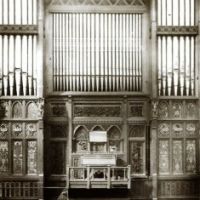
It is but a distant memory today. The magnificent instrument, which stood against the back wall of Springer Auditorium, was dismembered in 1974 and literally consigned to the rubbish heap.
“It was thrown away,” said Robert Schaffer, 87, retired organist at the Cathedral Basilica of the Assumption in Covington who played the Music Hall organ for May Festival and Cincinnati Symphony Orchestra concerts during the 1950s and 60s.
“It was torn down to provide space for opera and dancing. It was simply a question of space - of taking it away because it was IN the way.”
Panels from the organ's elaborate hand-carved screen are all that survive of “The Cincinnati Organ” (the 1878 book of that name, edited by George Ward Nichols, has been digitized by Google and can be accessed online).
Cincinnati was a center
for art-carved furniture in the late 19th-century.
There was a wood-carving department at the University of Cincinnati
School of Design (now the Art Academy) headed by Benn Pitman and a private
school of carving and design run by William Fry and his son Henry. Pitman,
the Frys and their students - over 100 carvers, most of them women -
undertook to make the organ screen. Reuben Springer, prime mover
of Music Hall, offered cash prizes for the best of the women's work.
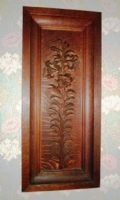
The theme was “music in form,”
with panels of birds and insects, the times of day (morning, noon and
night) and 15 composers represented by botanical imagery associated
with them (laurel for Bach, oak for Beethoven, rose for Schumann, etc.).
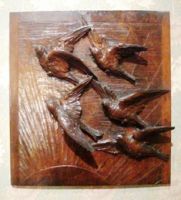
The screen was taken apart in 1971 and panels were moved to the back wall of the orchestra pit. There are three in the Cincinnati Wing of the Art Museum in Eden Park and a pair hanging at foot of the stairs in the North Wing of Music Hall. Some were auctioned off.
What brought down this fairy tale instrument?
Size, placement in the auditorium, expanding uses of Music Hall, neglect and some unfortunate decisions, said Schaffer.
“The organ was that large because Music Hall was just one building with the organ up there and nothing in front of it,” he said. That changed in 1895, when an attempt was made to convert Springer Auditorium from a choral festival hall into an all-purpose hall. A new stage and a double proscenium were built, the larger for symphony concerts, the smaller for opera and theatrical events.
It was a largely a fruitless endeavor, since the CSO moved into its own custom-built concert hall in 1912 (Emery Auditorium), and Cincinnati Opera, founded in 1920, performed in a pavilion at the Cincinnati Zoo until moving to Music Hall in 1972.
The organ, its voice muted behind the proscenium, became a stepchild, still played for May Festivals, high school graduations and other events, but an object of controversy.
Historian/CSO violist Robert Howes recently located an April, 1895 document giving a fuller picture of what happened -- or more precisely did not -- during the 1895 renovation:
“The document,” said Howes, “is a proposal by the Hannaford firm (architects of Music Hall) regarding the remodeling, and it specifically states that the organ pipe chambers were to be relocated in a space at house left that was going to be designed and worked into the new proscenium. It did not happen because they ran out of time and/or money, or they realized when it came time to try to fit it into the space they thought they could fit it into, they couldn't. So they decided just to leave it where it was.”
The organ was updated in the 1920s when the hydraulic pumps that drove the bellows were replaced by electrical ones. “They made it mechanically better, but it lost some of its zip in tonal quality,” said organist Roger Heather, who practiced on the Music Hall organ when he was a student at the Cincinnati College of Music after World War II. The problem, said Schaffer, was that a builder was hired to try to give it more of an “orchestral sound.”
As the years went by, the
organ languished behind the proscenium. Care and maintenance were
neglected. There was inadequate temperature control, plus leakage
from the roof and dust accumulation. When it was played with the
orchestra, there were timing and tuning issues. Schaffer remembers
having to be cued from the wings by May Festival Chorus director Elmer
Thomas to try to keep the later-sounding organ in sync with the conductor.
Former CSO violinist Rosemary Waller recalls how painfully flat it was
compared to standard orchestra pitch.
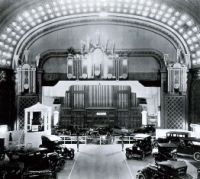
The final blow came when in the late 1960s J. Ralph Corbett, his wife Patricia and the Corbett Foundation funded a comprehensive renovation of Music Hall. Inevitably, the problem of the organ came up.
Ralph Corbett, who was chairman of the Music Hall board of trustees, made one last attempt to save it. There were three concerns: COULD the organ be re-located without interfering with Music Hall's superior acoustics? SHOULD the old organ be saved or a new one installed? HOW MUCH would it cost?
Consultants were called in and advice and estimates given: Repairs to the old organ would cost at least $175,000, most of it for cleaning. Price tag for a new pipe organ was $250,000-$300,000.
With the Corbett Foundation already committed to the hilt (ultimately $6 million), Corbett looked to other sources. “We approached other patrons to see if anyone would be willing to pay for the organ and we met with stony silence. We couldn't get the money.” The Corbett Foundation, partly influenced by CSO music director Thomas Schippers, himself an organist, paid $100,000 for a portable electronic organ.
“Some of the pipes went to churches around town,” said Heather, who owns one himself. Others were sold or scavenged. “There were pipes laying right out on the street,” said Schaffer, “great pipes that would have cost plenty of money and were top notch quality.”
Highly touted at its 1974
debut, the brand new Baldwin electronic “Multi-Waveform” organ proved
no substitute for the original. Schippers was soloist in Poulenc's
Concerto for Organ, Strings and Timpani, simultaneously conducting the
CSO. Enquirer music critic Gail Stockholm had this to say in her
October 12 review: “As it now stands, I am conscious of the
electronic basis of the sound, a quality that I believe is not desirable.”
Schaffer, who in 1970 rescued the fine old pipe organ from St. Joseph's Church in Covington and had it installed in the gallery of the Cathedral Basilica, takes a dim view in general of replacing pipe organs with electronic ones: “Those things are not pipe organs. They're phony. I can see playing them on gigs and for skating rinks. They don't belong with the CSO. Something should be done to get some real music sounds back into Music Hall.”
(first published in "Music Hall Marks," newsletter of the Society for the Preservation of Music Hall, Winter, 2010.)